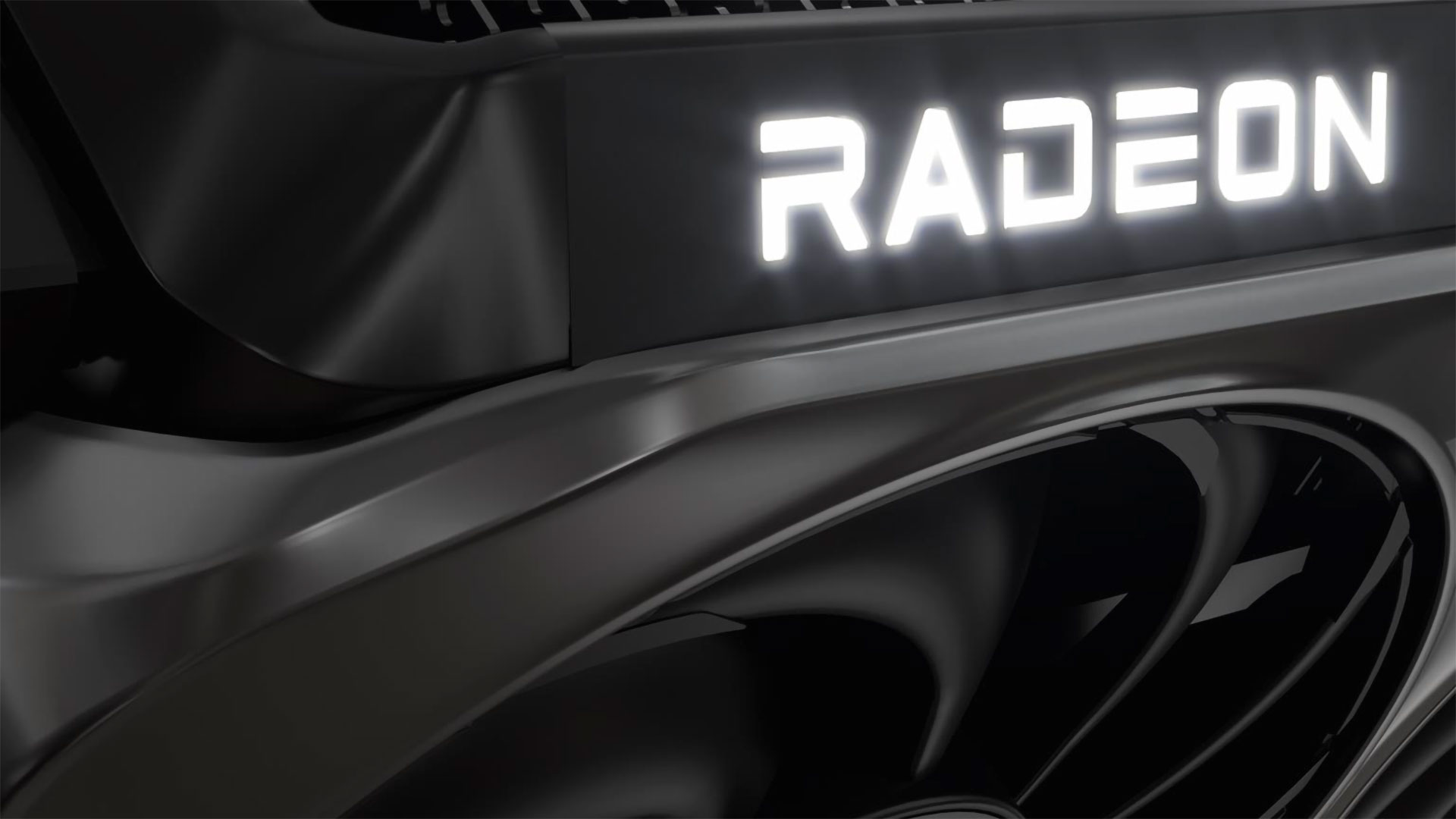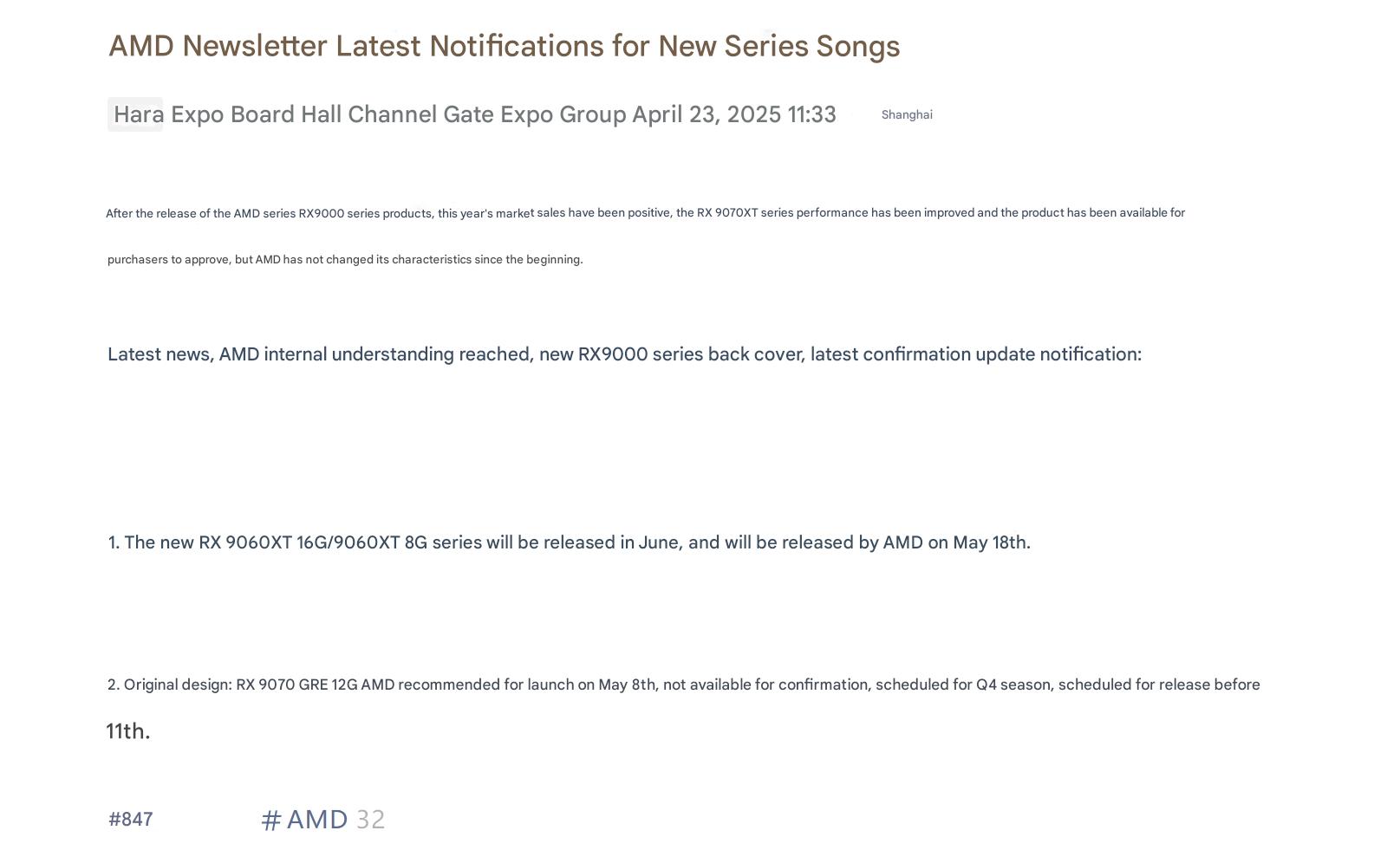AMD RX 9060 XT GPUs reportedly target a May 18 launch — RX 9070 GRE tipped for a Q4 release
Hopefully, we'll see performance leaks shortly.

Originally anticipated by early June, a new rumor suggests that AMD's RX 9060 XT GPUs could hit shelves on May 18, a shift of around two or three weeks. This leak originates from Board Channels, a network of sources allegedly linked to board partners. The same source also claims the RX 9070 GRE, a recurring subject in many leaks nowadays, has, purportedly, been pushed back to the fourth quarter, and we might have a good explanation for that.
AMD updated its RDNA 4 nomenclature to align with Nvidia's "X0X0" convention, probably to simplify customer understanding, even if it comes at the expense of its original identity. The RX 9060 XT family will reportedly offer 8GB and 16GB memory configurations, shifting to the budget Navi 44 die with 2,048 shaders (32 CUs) and clock speeds north of 3 GHz. Leaked specifications suggest the RX 9070 GRE, on the other hand, is equipped with a cut-down Navi 48 die packing 3,072 shaders (48 CUs) and a 12GB frame buffer.
Despite initially being suggested for a Computex reveal, followed by a launch in early June, Board Channels alleges that AMD is expediting the RX 9060 XT for launch just before Computex. By launch, we're assuming the source refers to on-shelf inventory. More interestingly, the mid-range RX 9070 GRE is apparently delayed from early May to October or November, just before 11.11 (Singles' Day in China), the largest online and offline shopping event globally.

Let's address the elephant in the room: the RX 9060 XT 8GB. Across various resolutions, including 1080p and 1440p, there's a sizeable performance gap between the RTX 5060 Ti 8GB and 16GB. And let's not forget that Nvidia's use of GDDR7 can alleviate potential memory bottlenecks, a luxury AMD does not have this generation.
This could have been the perfect opportunity for AMD to hit Nvidia where it hurts: memory capacity. The growing need for more video memory might incentivize consumers to cough up more dollars for the 16GB model. It makes me wonder why the 8GB model exists in the first place, considering the overlap with a potential RX 9060 non-XT.
The RX 9070 GRE, on the other hand, is reportedly built using binned Navi 48 dies, or to be precise, dies with 25% fewer shaders. Due to the maturity of TSMC's N4 process, achieving a large volume of significantly cut-down Navi 48 GPUs might be difficult. One possibility for the sudden change in plans is that the RX 9070 GRE is now aimed for a global launch, and AMD is taking time to procure the necessary volume of binned GPUs, but that's just speculation.
Follow Tom's Hardware on Google News to get our up-to-date news, analysis, and reviews in your feeds. Make sure to click the Follow button.
Get Tom's Hardware's best news and in-depth reviews, straight to your inbox.

Hassam Nasir is a die-hard hardware enthusiast with years of experience as a tech editor and writer, focusing on detailed CPU comparisons and general hardware news. When he’s not working, you’ll find him bending tubes for his ever-evolving custom water-loop gaming rig or benchmarking the latest CPUs and GPUs just for fun.
-
usertests I think that pretty much confirms the 9070 GRE is irrelevant outside of China, and may NOT get a global release. If yields are good most chips should become 9070 non-XT or XT.Reply
9060 XT 8 GB should be faster (maybe not?) than the 5060 8 GB but slower than the 5060 Ti 8 GB. If it undercuts the 5060 with for example a $280 MSRP, and gets sold for even less, then it has some relevance. AMD's most popular dGPU on Steam Survey is the RX 6600 non-XT, and the 9060 XT could be 40-60% faster, although stuck at 8 GB.
Nvidia has the option to refresh the 5060 with 12 GB while AMD can't do that with the GDDR6 in the 9060 XT. -
GenericUser2001 If Nvidia refreshes the 5060 with 12 GB AMD does have the option of just not making 8 GB versions, and going full 16 GB for that tier of cards. I would wager that 16 GB of GDDR6 AMD is using is probably pretty much the same price as 12 GB of GDDR7, maybe even cheaper.Reply -
Notton Looking back at Navi 1~3, the only time they did a dedicated 192-bit chip was with Navi 22.Reply
Navi 32: 7700XT 12GB is a cut down 7800XT 16GB.
Navi 22: 6750XT 12GB full configuration. The cut down version is a 6700XT 10GB.
Navi 10: 5600XT 6GB is a cut down 5700XT 8GB.
I'm guessing the lack of 192-bit on 9060XT is because the same can be achieved with a cut down Navi 48.
As for the China limited launch in Q4, that's still a ton of cards. Assuming it's not a paper launch, I'm guessing yields are good, but not fantastic enough to result in a Microcenter only 5600X3D type of ordeal.
Technically Nvidia could do a 5060 12GB with 3GB chips for $350~400...GenericUser2001 said:If Nvidia refreshes the 5060 with 12 GB AMD does have the option of just not making 8 GB versions, and going full 16 GB for that tier of cards. I would wager that 16 GB of GDDR6 AMD is using is probably pretty much the same price as 12 GB of GDDR7, maybe even cheaper.
but why do that when using 96GB of 3GB chips results in a $10,000 to $20,000 card with Blackwell Pro. -
usertests Reply
You could make the same argument for them making any consumer Blackwell GPUs at all. Just turn all the wafers into AI accelerators and send them over to OpenAI. Consumer Blackwell GPUs have reportedly had terribly low supply, so I guess that's already happening.Notton said:Technically Nvidia could do a 5060 12GB with 3GB chips for $350~400...
but why do that when using 96GB of 3GB chips results in a $10,000 to $20,000 card with Blackwell Pro.
I would hope that by the end of 2025, there are plenty of reasonably priced 3 GB GDDR7 modules available for refreshes, and AMD can use them for their next gen of cards later in 2026. Intel may also be using GDDR7 for Celestial according to this job leak. -
Notton At this point, I assume nvidia already allocated 99.5% of capacity to AI and the gaming stuff is 0.5%.Reply